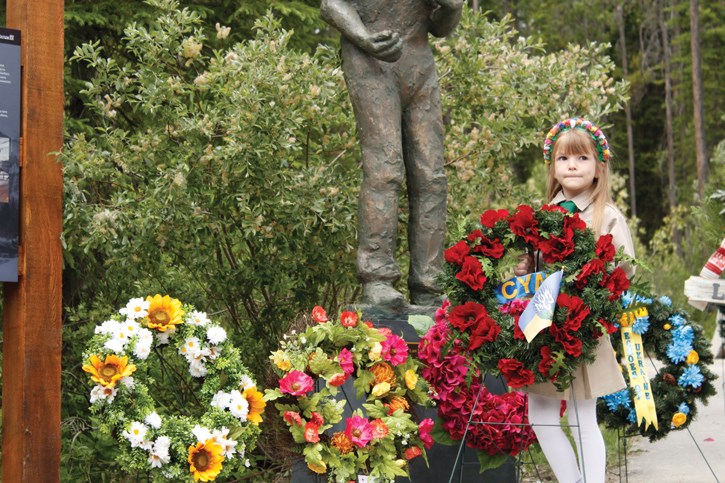YOHO – Concentration camps from the First World War in Canada have had a “crippling legacy” for those that survived being interned for who they were and where they came from.
But thanks to the efforts of the Canadian First World War Internment Recognition Fund and Parks Canada, there are now places where the history of the thousands of new immigrants to Canada who had their freedom taken away and human rights violated from 1914-20 is being shared publicly.
That includes the Natural Bridge day use area in Yoho National Park, near Field, B.C., which is near the location of Camp Otter – an internment camp for those of Eastern European descent who were declared enemy aliens as Canada entered the First World War.
For Emil Yereniuk, with the recognition fund, recognizing these historical injustices and sharing the stories of those who were rounded up, held prisoner and forced to work during their internment, is of the utmost importance, now more than ever.
“Most were Ukrainian and most were civilian,” Yereniuk said. “We keep repeating that, but we can’t forget – we cannot forget that.
“These men, women and children were interned in over 24 internment camps across Canada … they were used as forced labour to build infrastructure.”
Those kept prisoner at Camp Otter in Yoho, as well as interment camps in Revelstoke, Jasper and Banff National Parks, were used by then Parks Commissioner J.B. Harkin as a source of cheap labour to build roads, trails and the infrastructure that still exists todays in the Rocky Mountain national parks.
The use of prisoners of war as cheap labour was contrary to the 1907 Hague Convention, that set out that POWs would not be required to work, except for their own upkeep.
“They were required not only to construct the internment camps, but to work on road building, land clearing, wood cutting and railway construction projects, often to the profit of their jailers,” said Borys Sydoruk with the Ukrainian Canadian Civil Liberties Association. “These people were interned not because of any wrongdoing, but because of who they were.
“This is about human rights on the most fundamental level.”
In total, 8,579 people were held as enemy aliens after the War Measures Act was implemented in 1914 at the onset of the First World War. Sydoruk pointed out that only 3,138 of those held could be technically considered prisoners of war. While many were Ukrainian, those interned included other Eastern European heritage like Armenians, Croatians, Bulgarians, Czechs, Bulgarians, Hungarians, Romanians and Serbians, to name but a few.
For those who were German or of German speaking Austrian descent, their internment was not as difficult as those who were sent to camps in western Canada and forced to work in challenging winter conditions.
But one of the most harmful legacies from this era of Canadian history has been the denial that it even happened. For many Ukrainians, the past was all but erased from the history books of Canada and forgotten.
“One of the gravest forms of injustice is when the victims cannot tell their story, when they are silenced by denial or indifference, when they are marginalized and pushed to the periphery of history,” Sydoruk said.
In 2005, after many years of work by Ukrainian Canadians and the civil liberties association, the Internment of Persons of Ukrainian Origins Recognition Act was passed in the House of Commons.
The legislation made it possible for the establishment of the internment recognition fund to support education and commemorative activities and projects. The goal was to remind all Canadians of this episode in the country’s history so it cannot be forgotten, no matter how uncomfortable it is.
For Rick Kubian, with the Yoho, Kootenay and Lake Louise field unit of Parks Canada, part of honouring the past is also talking about those difficult periods of our country’s history.
“Parks Canada recognizes the legacy of Camp Otter and the First World War internment operations,” Kubian said. “Through interpretive programming and materials, Parks Canada is committed to ensuring Canadians have an opportunity to learn about the full scope of our history including the difficult periods that are a part of our past.”
Camp Otter contained up to 200 internees in Yoho, but was only operational for less than a year. Those in the camp survived the first winter in 1915, but went on strike the following summer. They refused to work, determined to not spend another winter in Canada’s hinterland, and the camp closed in October 1916.
While most were relocated to the camps in Banff, or Spirit Lake, Que., others were released on parole.
In addition to the exhibit at the Cave and Basin that opened in 2013 to share the story of the interment camps in the national parks, Parks Canada also reinstalled interpretive panels in Yoho and a brand new sculpture by artist John Boxtel.
The panels, located near the parking lot to the Natural Bridge feature, were originally installed in 2008 and were weathered over the past 10 years.
Boxtel’s sculptures have been installed in locations where interment camps are being recognized as part of Canada’s past. The last sculpture to be unveiled was the one in Yoho, titled Last Man Standing.
Yereniuk said Boxtel’s work represents an important milestone in remembering and recognizing the historic injustice suffered by thousands of innocent people.
“The Last Man Standing exhibits the strength and reliance of thousands of new immigrants invited to Canada who then found themselves interned and working for little pay in Canada’s hinterland against their will.
“We honour those who were interned here in Yoho National Park and with the words of the internees … I beg you do not forget.
“Please do not forget.”
Go to www.internmentcanada.ca for more information of Canada’s First World War Internment Recognition Fund.




